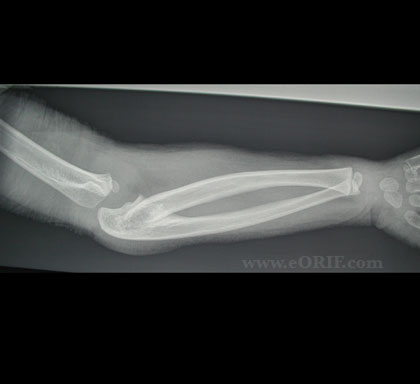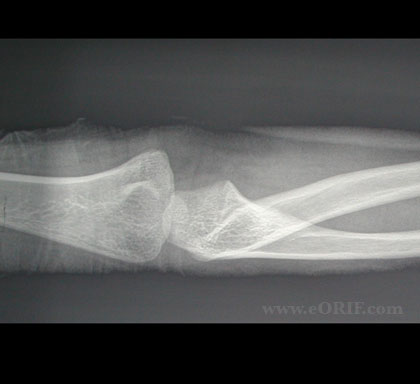|


|
synonyms:
Congenital Radioulnar Synostosis ICD-10
Congenital Radioulnar Synostosis ICD-9
- 755.53 Radioulnar synostosis
Congenital Radioulnar Synostosis Etiology / Epidemiology / Natural History
- lack of pronation and suppination in an infant
- generally not discovered until age 3-5
- longitudinal arrest of segmentation
- may initially be a synchondrosis which later ossifies
- function depends on severity of deformity
- with severe pronation deformity pt cannot fulycompensate with scapular and GH motion
- M=F
- 60% bilateral
- Familial cases with autosommal dominant inheritance has been reported (Rizzo R, Am J Med Genet 1997;68:127).
Congenital Radioulnar Synostosis Anatomy
- May have absence of brachioradialis, pronator teres, pronator quadratus, and supinator
Congenital Radioulnar Synostosis Clinical Evaluation
Congenital Radioulnar Synostosis Xray / Diagnositc Tests
- A/P, lateral and oblique elbow films indicated. Synostosis is evident on xrays.
Congenital Radioulnar Synostosis Classification / Treatment
- Treatment generallynot indicated (Cleary JE, JBJS 1985;67Am:539).
- treatment not necessary if mild unilateral or no major functional loss.
- if bilateral and severe pronation—extensive release of synostosis, interosseous membrane, radioulnar joints, excision of distal ulna, soft tissue interposition—none consistently useful
- recommend rotational osteotomy through synostosis site for pronation >45 degrees. If unilateral place in 20 degrees supination; if bilateral place dominant side in 30 degrees pronation and assistive limb in neutral Repositioning one forearm into suppination no longer recommended because bilateral pronation is necessary for computer keyboarding
Congenital Radioulnar Synostosis Associated Injuries / Differential Diagnosis
- Alperts Syndrome
- Carpenter's syndrome
- Klinefelters Syndrome
- Arthrogryposis
- Radial head dislocation
- DDH,
- clubfoot
- preaxial dysmelias
- acrocephalosyndactyly
- chromosome abnormalities (duplication of sex chromosomes, XXXY)
- Radioulnar synostosis (post-traumatic/post-surgical)
Congenital Radioulnar Synostosis Complications
Congenital Radioulnar Synostosis Follow-up Care
- Asymptomatic patients can be as active in sports as their function allows. May consider limiting contact sports.
Congenital Radioulnar Synostosis Review References
- Ramachandran M, JBJS 2005;87Br:1406
- Fujimoto M, JPO 2005;25:676
- Kanaya F, JBJS 1998;80A:1186
|


